Analyzing Gender Pay Gap: An ASDA Case Study on Equality & Diversity
VerifiedAdded on 2023/01/17
|24
|3479
|73
Case Study
AI Summary
This case study investigates the gender pay gap at ASDA, a British multinational supermarket retail company, focusing on equality and diversity in the workplace. It aims to analyze the reasons for wage disparity between men and women, exploring its impact on employee performance and identifying ways to eradicate negative effects. The study uses a qualitative research approach with data collected through surveys and secondary sources like journals and books. The data analysis reveals insights into employee perceptions of equality, the impact of disparity on performance, company efforts to reduce the gender pay gap, and effective strategies for promoting equality and diversity. The case study concludes with recommendations for creating equal opportunities and addressing common factors of discrimination within the organization.

Equality and diversity in the workplace.
Paraphrase This Document
Need a fresh take? Get an instant paraphrase of this document with our AI Paraphraser
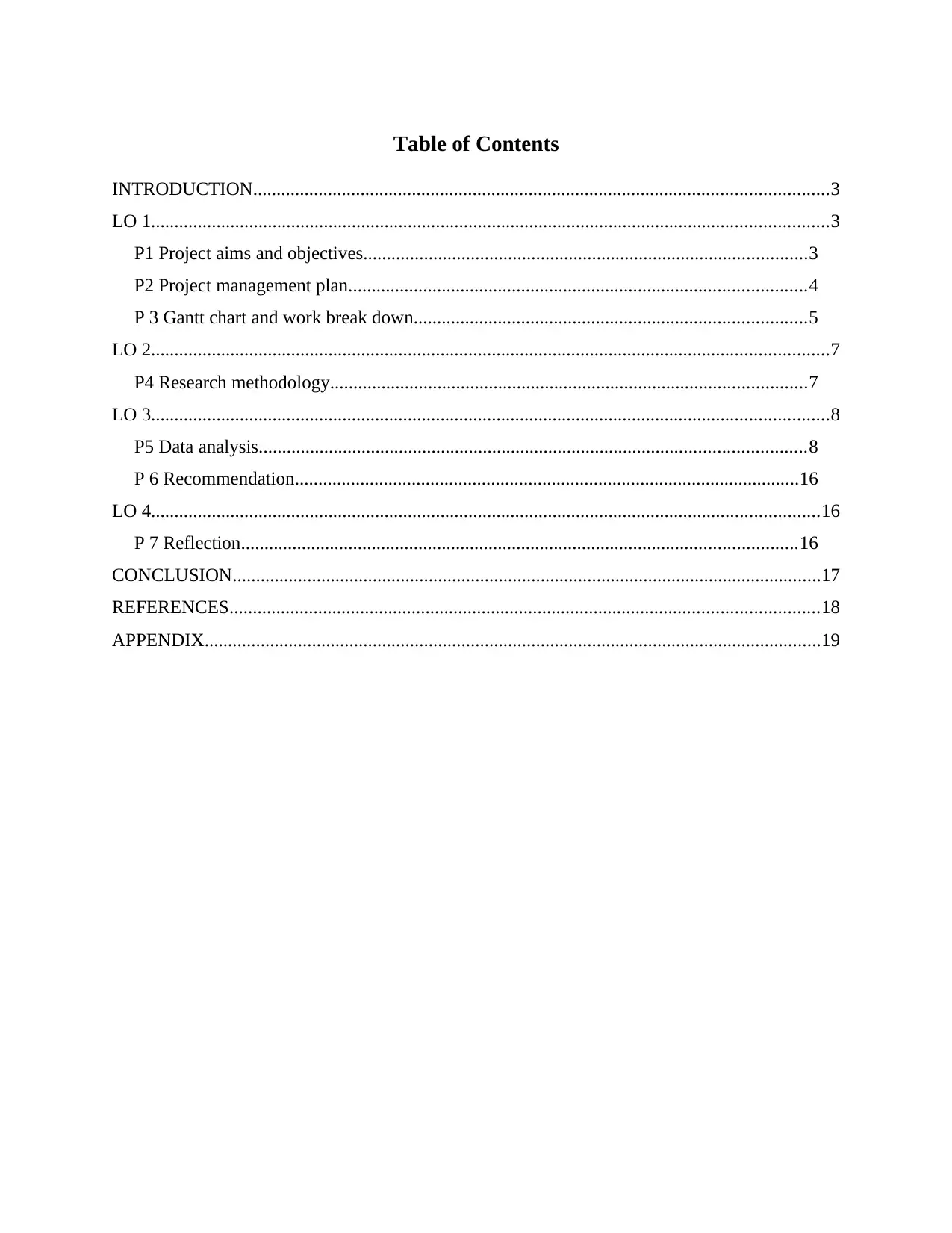
Table of Contents
INTRODUCTION...........................................................................................................................3
LO 1.................................................................................................................................................3
P1 Project aims and objectives...............................................................................................3
P2 Project management plan..................................................................................................4
P 3 Gantt chart and work break down....................................................................................5
LO 2.................................................................................................................................................7
P4 Research methodology......................................................................................................7
LO 3.................................................................................................................................................8
P5 Data analysis.....................................................................................................................8
P 6 Recommendation............................................................................................................16
LO 4...............................................................................................................................................16
P 7 Reflection.......................................................................................................................16
CONCLUSION..............................................................................................................................17
REFERENCES..............................................................................................................................18
APPENDIX....................................................................................................................................19
INTRODUCTION...........................................................................................................................3
LO 1.................................................................................................................................................3
P1 Project aims and objectives...............................................................................................3
P2 Project management plan..................................................................................................4
P 3 Gantt chart and work break down....................................................................................5
LO 2.................................................................................................................................................7
P4 Research methodology......................................................................................................7
LO 3.................................................................................................................................................8
P5 Data analysis.....................................................................................................................8
P 6 Recommendation............................................................................................................16
LO 4...............................................................................................................................................16
P 7 Reflection.......................................................................................................................16
CONCLUSION..............................................................................................................................17
REFERENCES..............................................................................................................................18
APPENDIX....................................................................................................................................19
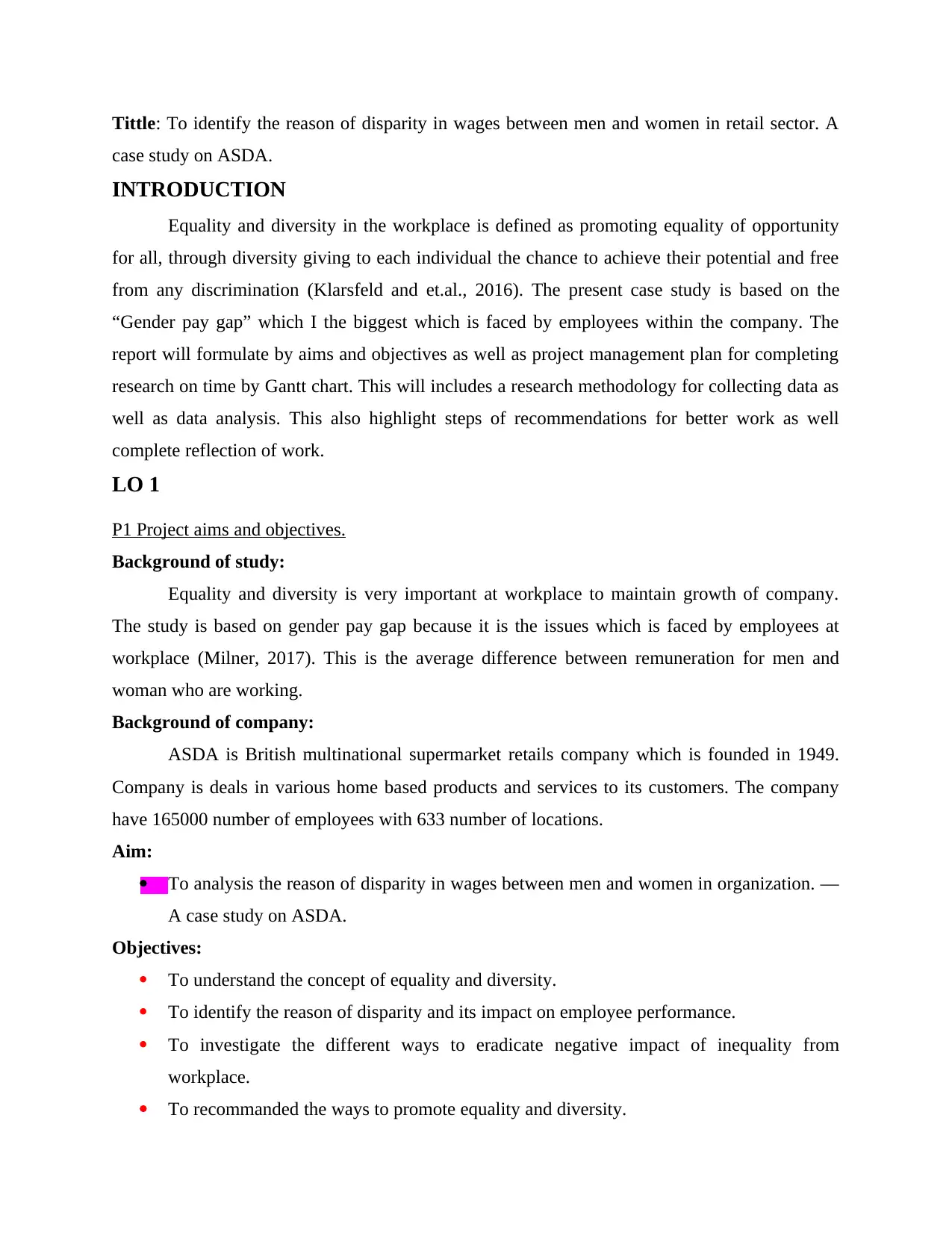
Tittle: To identify the reason of disparity in wages between men and women in retail sector. A
case study on ASDA.
INTRODUCTION
Equality and diversity in the workplace is defined as promoting equality of opportunity
for all, through diversity giving to each individual the chance to achieve their potential and free
from any discrimination (Klarsfeld and et.al., 2016). The present case study is based on the
“Gender pay gap” which I the biggest which is faced by employees within the company. The
report will formulate by aims and objectives as well as project management plan for completing
research on time by Gantt chart. This will includes a research methodology for collecting data as
well as data analysis. This also highlight steps of recommendations for better work as well
complete reflection of work.
LO 1
P1 Project aims and objectives.
Background of study:
Equality and diversity is very important at workplace to maintain growth of company.
The study is based on gender pay gap because it is the issues which is faced by employees at
workplace (Milner, 2017). This is the average difference between remuneration for men and
woman who are working.
Background of company:
ASDA is British multinational supermarket retails company which is founded in 1949.
Company is deals in various home based products and services to its customers. The company
have 165000 number of employees with 633 number of locations.
Aim:
To analysis the reason of disparity in wages between men and women in organization. —
A case study on ASDA.
Objectives:
To understand the concept of equality and diversity.
To identify the reason of disparity and its impact on employee performance.
To investigate the different ways to eradicate negative impact of inequality from
workplace.
To recommanded the ways to promote equality and diversity.
case study on ASDA.
INTRODUCTION
Equality and diversity in the workplace is defined as promoting equality of opportunity
for all, through diversity giving to each individual the chance to achieve their potential and free
from any discrimination (Klarsfeld and et.al., 2016). The present case study is based on the
“Gender pay gap” which I the biggest which is faced by employees within the company. The
report will formulate by aims and objectives as well as project management plan for completing
research on time by Gantt chart. This will includes a research methodology for collecting data as
well as data analysis. This also highlight steps of recommendations for better work as well
complete reflection of work.
LO 1
P1 Project aims and objectives.
Background of study:
Equality and diversity is very important at workplace to maintain growth of company.
The study is based on gender pay gap because it is the issues which is faced by employees at
workplace (Milner, 2017). This is the average difference between remuneration for men and
woman who are working.
Background of company:
ASDA is British multinational supermarket retails company which is founded in 1949.
Company is deals in various home based products and services to its customers. The company
have 165000 number of employees with 633 number of locations.
Aim:
To analysis the reason of disparity in wages between men and women in organization. —
A case study on ASDA.
Objectives:
To understand the concept of equality and diversity.
To identify the reason of disparity and its impact on employee performance.
To investigate the different ways to eradicate negative impact of inequality from
workplace.
To recommanded the ways to promote equality and diversity.
⊘ This is a preview!⊘
Do you want full access?
Subscribe today to unlock all pages.

Trusted by 1+ million students worldwide
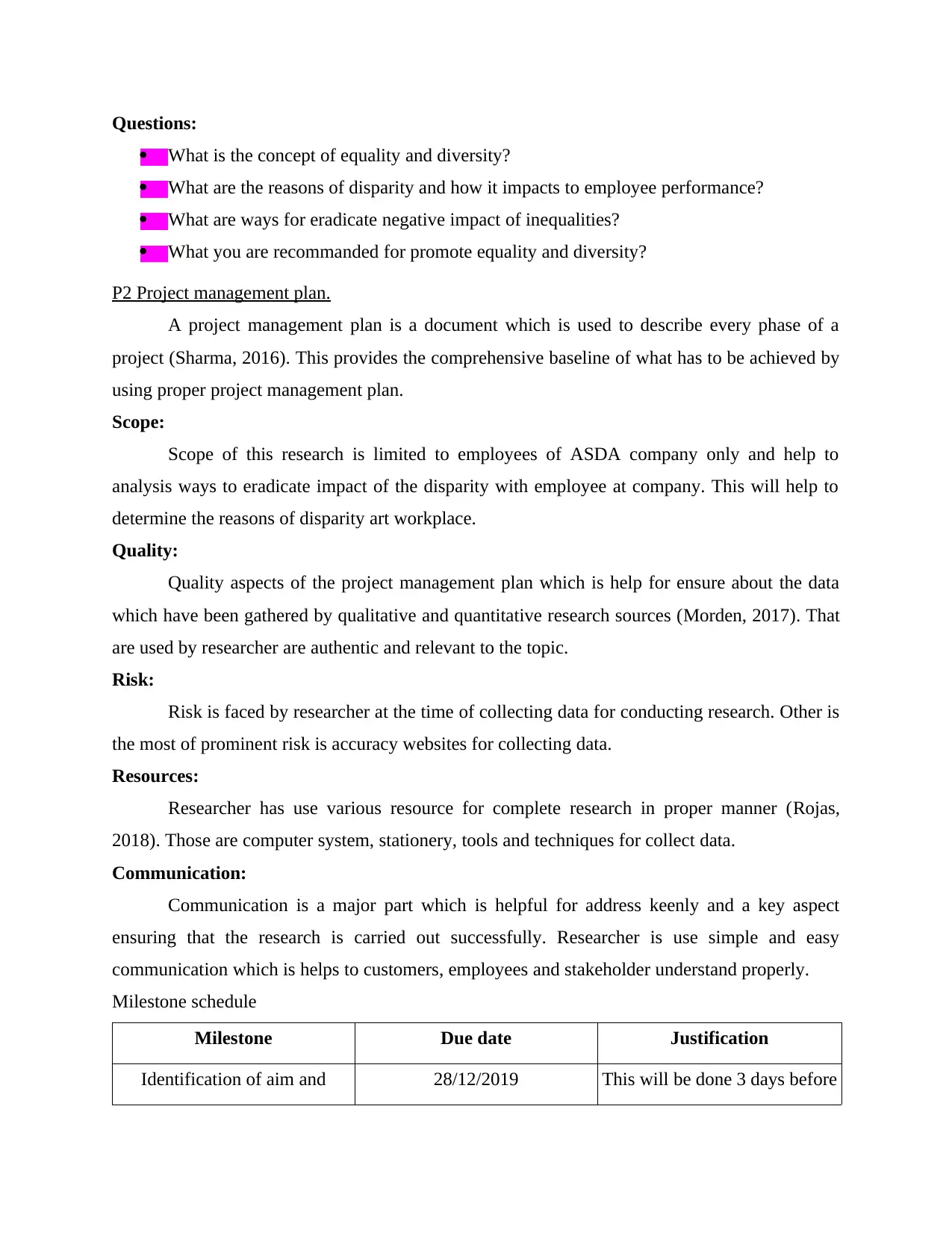
Questions:
What is the concept of equality and diversity?
What are the reasons of disparity and how it impacts to employee performance?
What are ways for eradicate negative impact of inequalities?
What you are recommanded for promote equality and diversity?
P2 Project management plan.
A project management plan is a document which is used to describe every phase of a
project (Sharma, 2016). This provides the comprehensive baseline of what has to be achieved by
using proper project management plan.
Scope:
Scope of this research is limited to employees of ASDA company only and help to
analysis ways to eradicate impact of the disparity with employee at company. This will help to
determine the reasons of disparity art workplace.
Quality:
Quality aspects of the project management plan which is help for ensure about the data
which have been gathered by qualitative and quantitative research sources (Morden, 2017). That
are used by researcher are authentic and relevant to the topic.
Risk:
Risk is faced by researcher at the time of collecting data for conducting research. Other is
the most of prominent risk is accuracy websites for collecting data.
Resources:
Researcher has use various resource for complete research in proper manner (Rojas,
2018). Those are computer system, stationery, tools and techniques for collect data.
Communication:
Communication is a major part which is helpful for address keenly and a key aspect
ensuring that the research is carried out successfully. Researcher is use simple and easy
communication which is helps to customers, employees and stakeholder understand properly.
Milestone schedule
Milestone Due date Justification
Identification of aim and 28/12/2019 This will be done 3 days before
What is the concept of equality and diversity?
What are the reasons of disparity and how it impacts to employee performance?
What are ways for eradicate negative impact of inequalities?
What you are recommanded for promote equality and diversity?
P2 Project management plan.
A project management plan is a document which is used to describe every phase of a
project (Sharma, 2016). This provides the comprehensive baseline of what has to be achieved by
using proper project management plan.
Scope:
Scope of this research is limited to employees of ASDA company only and help to
analysis ways to eradicate impact of the disparity with employee at company. This will help to
determine the reasons of disparity art workplace.
Quality:
Quality aspects of the project management plan which is help for ensure about the data
which have been gathered by qualitative and quantitative research sources (Morden, 2017). That
are used by researcher are authentic and relevant to the topic.
Risk:
Risk is faced by researcher at the time of collecting data for conducting research. Other is
the most of prominent risk is accuracy websites for collecting data.
Resources:
Researcher has use various resource for complete research in proper manner (Rojas,
2018). Those are computer system, stationery, tools and techniques for collect data.
Communication:
Communication is a major part which is helpful for address keenly and a key aspect
ensuring that the research is carried out successfully. Researcher is use simple and easy
communication which is helps to customers, employees and stakeholder understand properly.
Milestone schedule
Milestone Due date Justification
Identification of aim and 28/12/2019 This will be done 3 days before
Paraphrase This Document
Need a fresh take? Get an instant paraphrase of this document with our AI Paraphraser
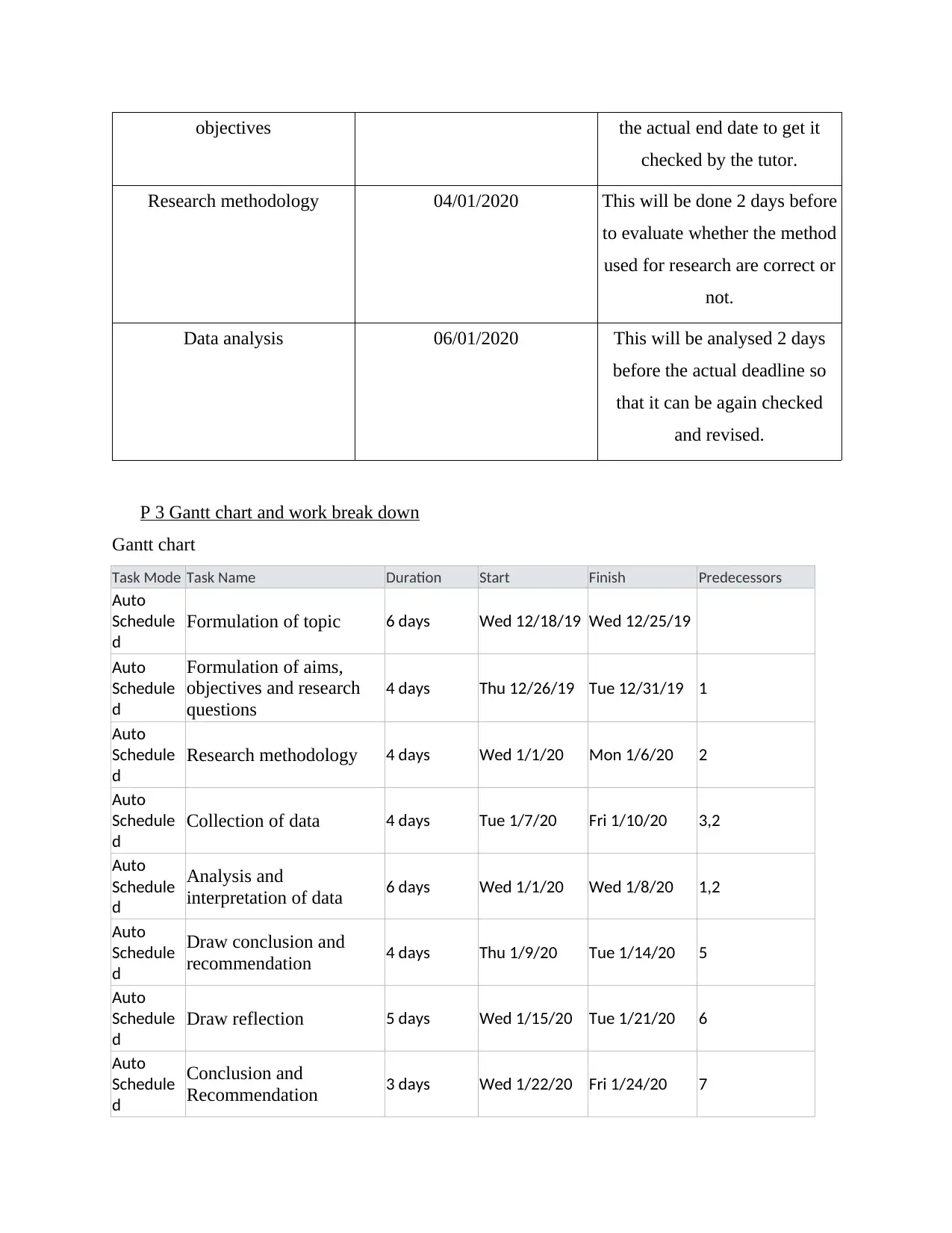
objectives the actual end date to get it
checked by the tutor.
Research methodology 04/01/2020 This will be done 2 days before
to evaluate whether the method
used for research are correct or
not.
Data analysis 06/01/2020 This will be analysed 2 days
before the actual deadline so
that it can be again checked
and revised.
P 3 Gantt chart and work break down
Gantt chart
Task Mode Task Name Duration Start Finish Predecessors
Auto
Schedule
d
Formulation of topic 6 days Wed 12/18/19 Wed 12/25/19
Auto
Schedule
d
Formulation of aims,
objectives and research
questions
4 days Thu 12/26/19 Tue 12/31/19 1
Auto
Schedule
d
Research methodology 4 days Wed 1/1/20 Mon 1/6/20 2
Auto
Schedule
d
Collection of data 4 days Tue 1/7/20 Fri 1/10/20 3,2
Auto
Schedule
d
Analysis and
interpretation of data 6 days Wed 1/1/20 Wed 1/8/20 1,2
Auto
Schedule
d
Draw conclusion and
recommendation 4 days Thu 1/9/20 Tue 1/14/20 5
Auto
Schedule
d
Draw reflection 5 days Wed 1/15/20 Tue 1/21/20 6
Auto
Schedule
d
Conclusion and
Recommendation 3 days Wed 1/22/20 Fri 1/24/20 7
checked by the tutor.
Research methodology 04/01/2020 This will be done 2 days before
to evaluate whether the method
used for research are correct or
not.
Data analysis 06/01/2020 This will be analysed 2 days
before the actual deadline so
that it can be again checked
and revised.
P 3 Gantt chart and work break down
Gantt chart
Task Mode Task Name Duration Start Finish Predecessors
Auto
Schedule
d
Formulation of topic 6 days Wed 12/18/19 Wed 12/25/19
Auto
Schedule
d
Formulation of aims,
objectives and research
questions
4 days Thu 12/26/19 Tue 12/31/19 1
Auto
Schedule
d
Research methodology 4 days Wed 1/1/20 Mon 1/6/20 2
Auto
Schedule
d
Collection of data 4 days Tue 1/7/20 Fri 1/10/20 3,2
Auto
Schedule
d
Analysis and
interpretation of data 6 days Wed 1/1/20 Wed 1/8/20 1,2
Auto
Schedule
d
Draw conclusion and
recommendation 4 days Thu 1/9/20 Tue 1/14/20 5
Auto
Schedule
d
Draw reflection 5 days Wed 1/15/20 Tue 1/21/20 6
Auto
Schedule
d
Conclusion and
Recommendation 3 days Wed 1/22/20 Fri 1/24/20 7
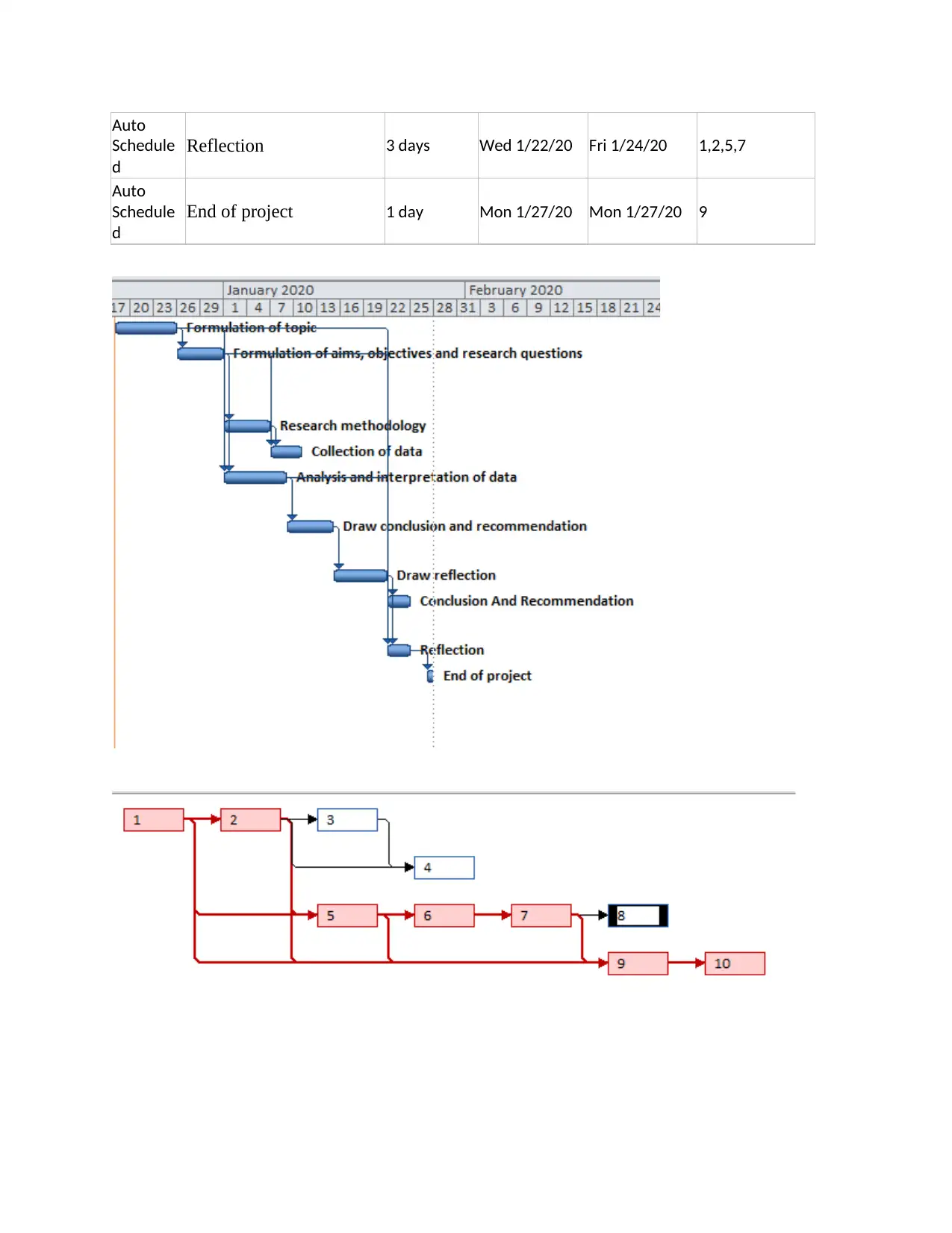
Auto
Schedule
d
Reflection 3 days Wed 1/22/20 Fri 1/24/20 1,2,5,7
Auto
Schedule
d
End of project 1 day Mon 1/27/20 Mon 1/27/20 9
Schedule
d
Reflection 3 days Wed 1/22/20 Fri 1/24/20 1,2,5,7
Auto
Schedule
d
End of project 1 day Mon 1/27/20 Mon 1/27/20 9
⊘ This is a preview!⊘
Do you want full access?
Subscribe today to unlock all pages.

Trusted by 1+ million students worldwide
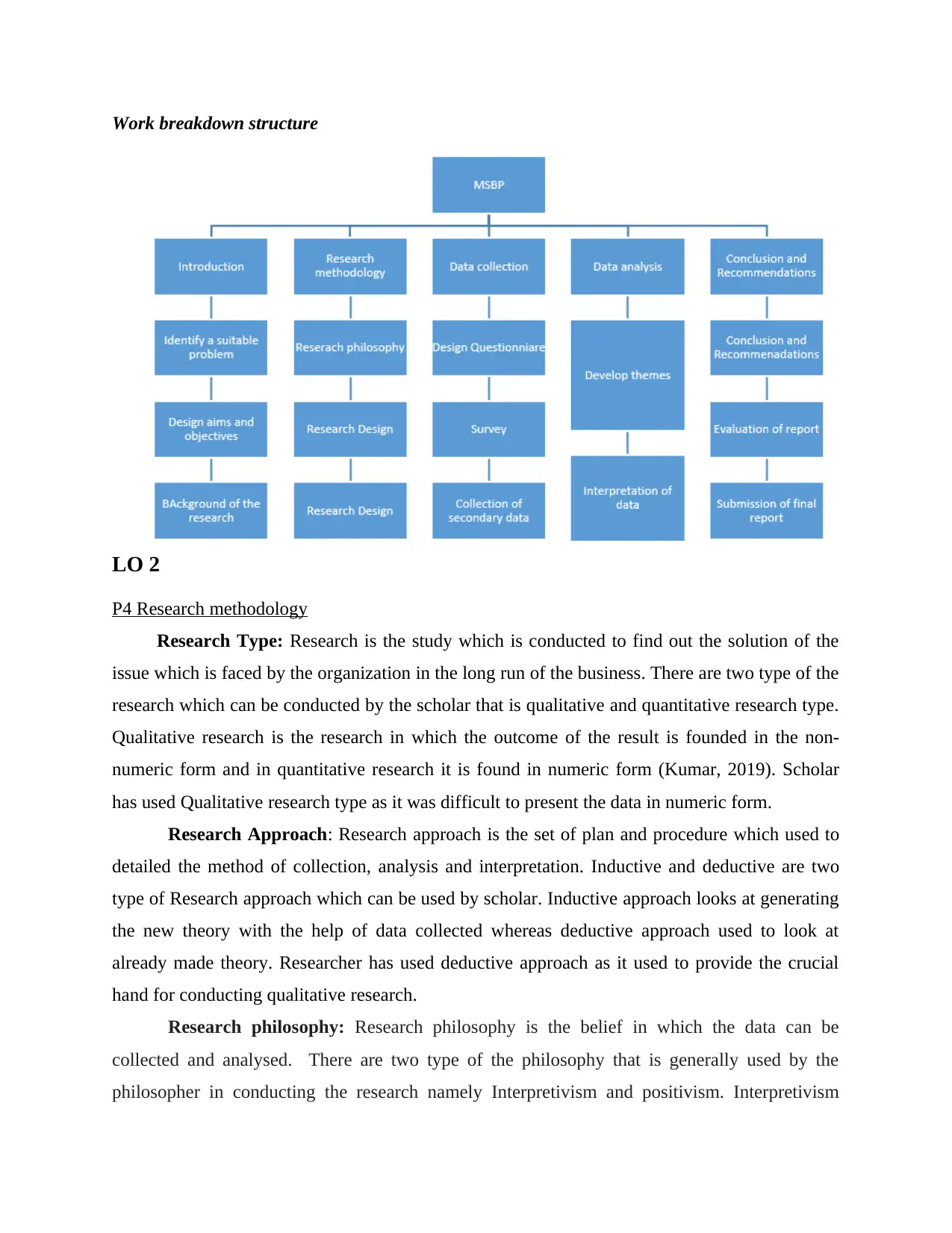
Work breakdown structure
LO 2
P4 Research methodology
Research Type: Research is the study which is conducted to find out the solution of the
issue which is faced by the organization in the long run of the business. There are two type of the
research which can be conducted by the scholar that is qualitative and quantitative research type.
Qualitative research is the research in which the outcome of the result is founded in the non-
numeric form and in quantitative research it is found in numeric form (Kumar, 2019). Scholar
has used Qualitative research type as it was difficult to present the data in numeric form.
Research Approach: Research approach is the set of plan and procedure which used to
detailed the method of collection, analysis and interpretation. Inductive and deductive are two
type of Research approach which can be used by scholar. Inductive approach looks at generating
the new theory with the help of data collected whereas deductive approach used to look at
already made theory. Researcher has used deductive approach as it used to provide the crucial
hand for conducting qualitative research.
Research philosophy: Research philosophy is the belief in which the data can be
collected and analysed. There are two type of the philosophy that is generally used by the
philosopher in conducting the research namely Interpretivism and positivism. Interpretivism
LO 2
P4 Research methodology
Research Type: Research is the study which is conducted to find out the solution of the
issue which is faced by the organization in the long run of the business. There are two type of the
research which can be conducted by the scholar that is qualitative and quantitative research type.
Qualitative research is the research in which the outcome of the result is founded in the non-
numeric form and in quantitative research it is found in numeric form (Kumar, 2019). Scholar
has used Qualitative research type as it was difficult to present the data in numeric form.
Research Approach: Research approach is the set of plan and procedure which used to
detailed the method of collection, analysis and interpretation. Inductive and deductive are two
type of Research approach which can be used by scholar. Inductive approach looks at generating
the new theory with the help of data collected whereas deductive approach used to look at
already made theory. Researcher has used deductive approach as it used to provide the crucial
hand for conducting qualitative research.
Research philosophy: Research philosophy is the belief in which the data can be
collected and analysed. There are two type of the philosophy that is generally used by the
philosopher in conducting the research namely Interpretivism and positivism. Interpretivism
Paraphrase This Document
Need a fresh take? Get an instant paraphrase of this document with our AI Paraphraser
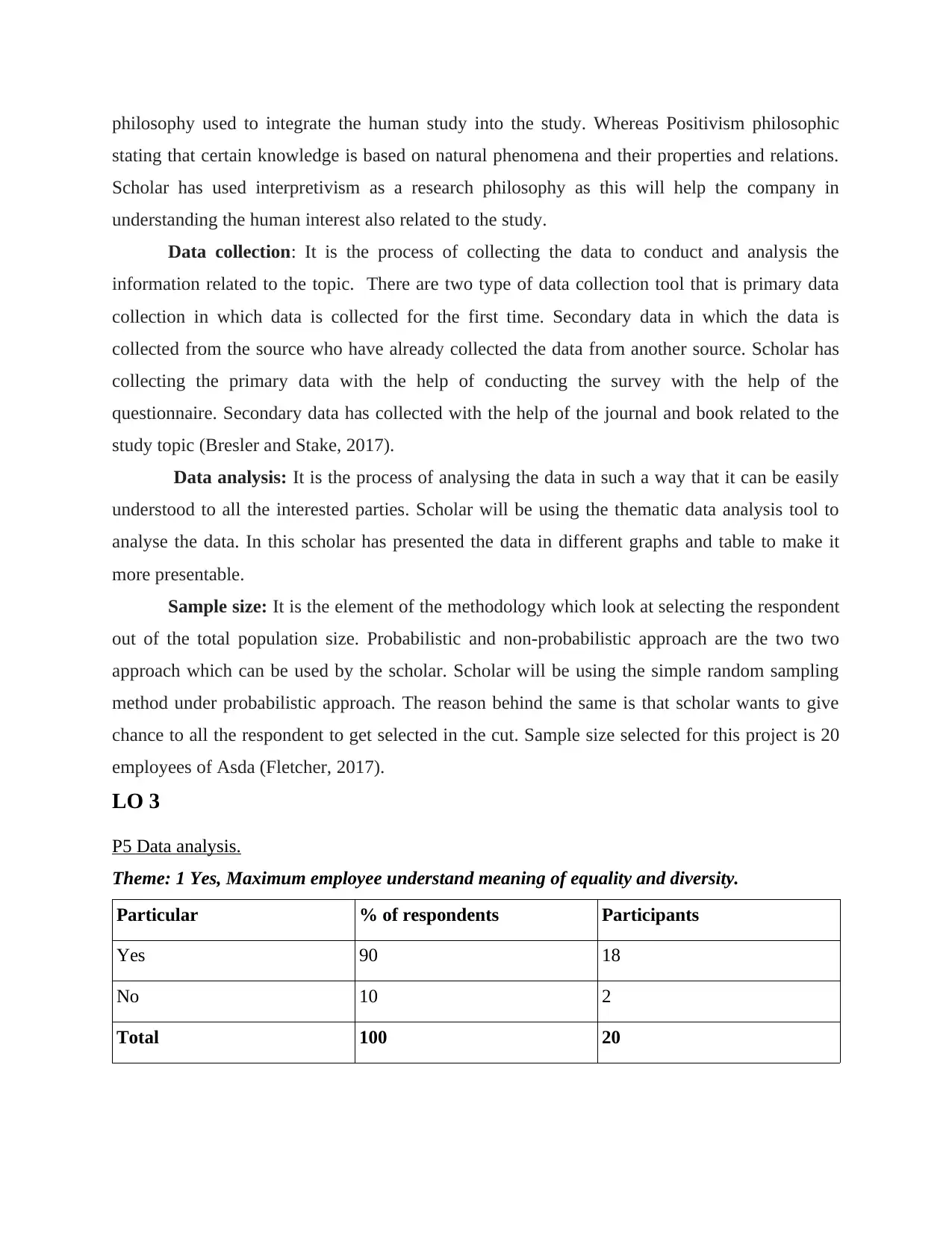
philosophy used to integrate the human study into the study. Whereas Positivism philosophic
stating that certain knowledge is based on natural phenomena and their properties and relations.
Scholar has used interpretivism as a research philosophy as this will help the company in
understanding the human interest also related to the study.
Data collection: It is the process of collecting the data to conduct and analysis the
information related to the topic. There are two type of data collection tool that is primary data
collection in which data is collected for the first time. Secondary data in which the data is
collected from the source who have already collected the data from another source. Scholar has
collecting the primary data with the help of conducting the survey with the help of the
questionnaire. Secondary data has collected with the help of the journal and book related to the
study topic (Bresler and Stake, 2017).
Data analysis: It is the process of analysing the data in such a way that it can be easily
understood to all the interested parties. Scholar will be using the thematic data analysis tool to
analyse the data. In this scholar has presented the data in different graphs and table to make it
more presentable.
Sample size: It is the element of the methodology which look at selecting the respondent
out of the total population size. Probabilistic and non-probabilistic approach are the two two
approach which can be used by the scholar. Scholar will be using the simple random sampling
method under probabilistic approach. The reason behind the same is that scholar wants to give
chance to all the respondent to get selected in the cut. Sample size selected for this project is 20
employees of Asda (Fletcher, 2017).
LO 3
P5 Data analysis.
Theme: 1 Yes, Maximum employee understand meaning of equality and diversity.
Particular % of respondents Participants
Yes 90 18
No 10 2
Total 100 20
stating that certain knowledge is based on natural phenomena and their properties and relations.
Scholar has used interpretivism as a research philosophy as this will help the company in
understanding the human interest also related to the study.
Data collection: It is the process of collecting the data to conduct and analysis the
information related to the topic. There are two type of data collection tool that is primary data
collection in which data is collected for the first time. Secondary data in which the data is
collected from the source who have already collected the data from another source. Scholar has
collecting the primary data with the help of conducting the survey with the help of the
questionnaire. Secondary data has collected with the help of the journal and book related to the
study topic (Bresler and Stake, 2017).
Data analysis: It is the process of analysing the data in such a way that it can be easily
understood to all the interested parties. Scholar will be using the thematic data analysis tool to
analyse the data. In this scholar has presented the data in different graphs and table to make it
more presentable.
Sample size: It is the element of the methodology which look at selecting the respondent
out of the total population size. Probabilistic and non-probabilistic approach are the two two
approach which can be used by the scholar. Scholar will be using the simple random sampling
method under probabilistic approach. The reason behind the same is that scholar wants to give
chance to all the respondent to get selected in the cut. Sample size selected for this project is 20
employees of Asda (Fletcher, 2017).
LO 3
P5 Data analysis.
Theme: 1 Yes, Maximum employee understand meaning of equality and diversity.
Particular % of respondents Participants
Yes 90 18
No 10 2
Total 100 20

Interpretation:
The above graph is stated that the maximum number of employees are understood about
the equality and diversity. They said the concept of equality and diversity is creates more
effectiveness for people and company performance. On the other side, the remaining 10%
employees are said they not understand the concept of equality and diversity and its process.
Theme: 2 Yes, according to majority disparity is affect to performance of employees.
Particular % of respondents Participants
Yes 75 15
No 25 5
Total 100 20
Yes No
0
10
20
30
40
50
60
70
80
90
90
10
% of respondents
The above graph is stated that the maximum number of employees are understood about
the equality and diversity. They said the concept of equality and diversity is creates more
effectiveness for people and company performance. On the other side, the remaining 10%
employees are said they not understand the concept of equality and diversity and its process.
Theme: 2 Yes, according to majority disparity is affect to performance of employees.
Particular % of respondents Participants
Yes 75 15
No 25 5
Total 100 20
Yes No
0
10
20
30
40
50
60
70
80
90
90
10
% of respondents
⊘ This is a preview!⊘
Do you want full access?
Subscribe today to unlock all pages.

Trusted by 1+ million students worldwide
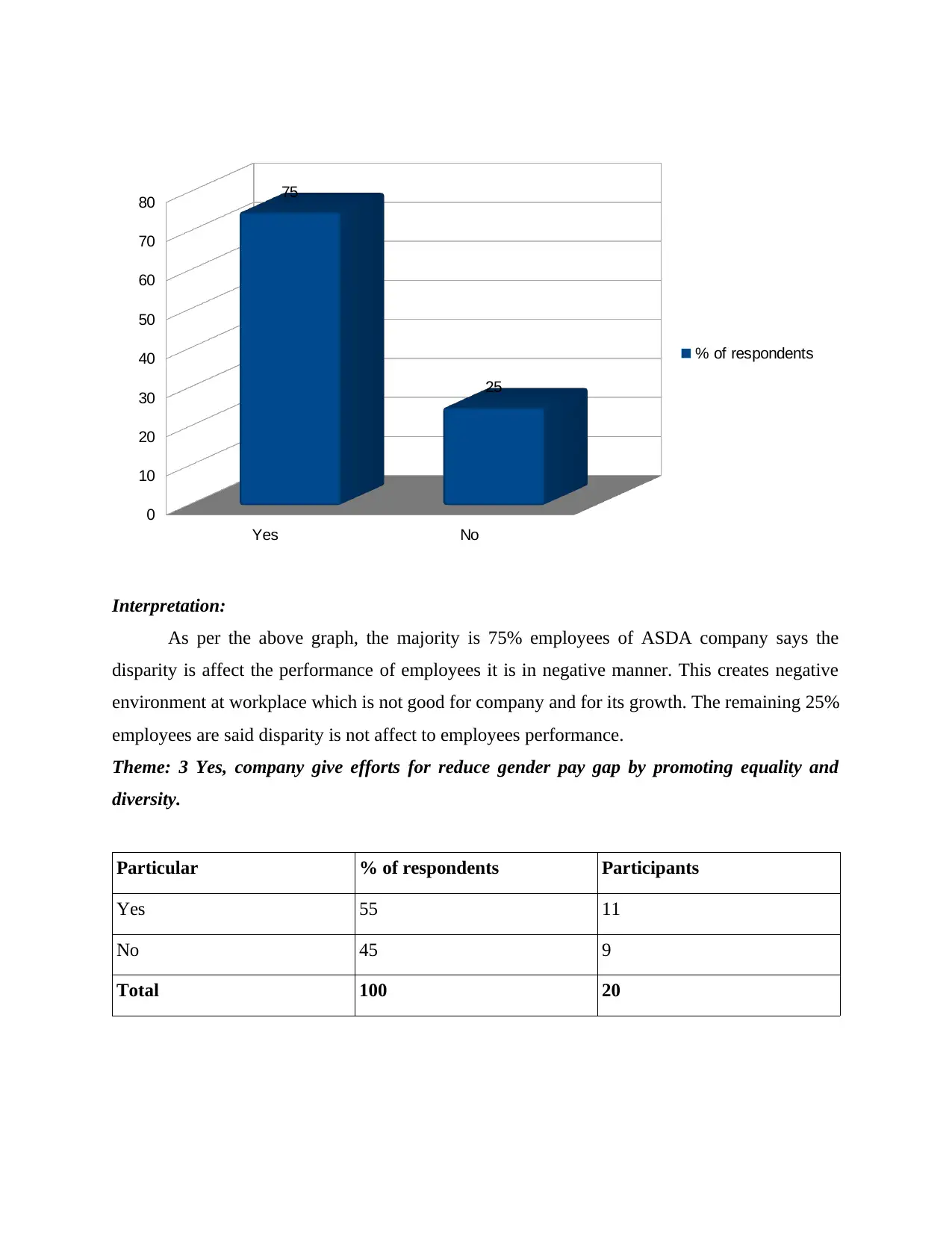
Interpretation:
As per the above graph, the majority is 75% employees of ASDA company says the
disparity is affect the performance of employees it is in negative manner. This creates negative
environment at workplace which is not good for company and for its growth. The remaining 25%
employees are said disparity is not affect to employees performance.
Theme: 3 Yes, company give efforts for reduce gender pay gap by promoting equality and
diversity.
Particular % of respondents Participants
Yes 55 11
No 45 9
Total 100 20
Yes No
0
10
20
30
40
50
60
70
80 75
25
% of respondents
As per the above graph, the majority is 75% employees of ASDA company says the
disparity is affect the performance of employees it is in negative manner. This creates negative
environment at workplace which is not good for company and for its growth. The remaining 25%
employees are said disparity is not affect to employees performance.
Theme: 3 Yes, company give efforts for reduce gender pay gap by promoting equality and
diversity.
Particular % of respondents Participants
Yes 55 11
No 45 9
Total 100 20
Yes No
0
10
20
30
40
50
60
70
80 75
25
% of respondents
Paraphrase This Document
Need a fresh take? Get an instant paraphrase of this document with our AI Paraphraser
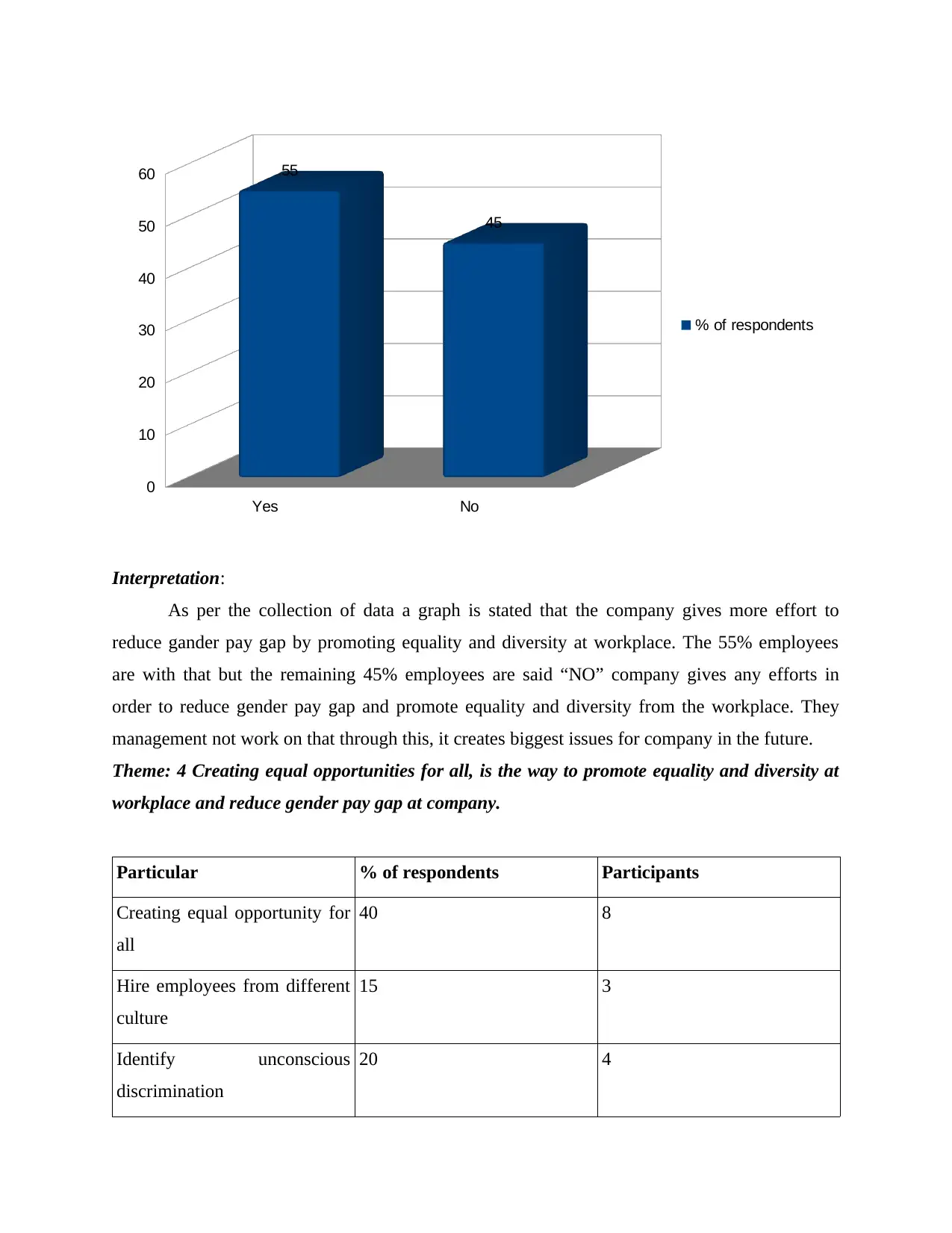
Interpretation:
As per the collection of data a graph is stated that the company gives more effort to
reduce gander pay gap by promoting equality and diversity at workplace. The 55% employees
are with that but the remaining 45% employees are said “NO” company gives any efforts in
order to reduce gender pay gap and promote equality and diversity from the workplace. They
management not work on that through this, it creates biggest issues for company in the future.
Theme: 4 Creating equal opportunities for all, is the way to promote equality and diversity at
workplace and reduce gender pay gap at company.
Particular % of respondents Participants
Creating equal opportunity for
all
40 8
Hire employees from different
culture
15 3
Identify unconscious
discrimination
20 4
Yes No
0
10
20
30
40
50
60 55
45
% of respondents
As per the collection of data a graph is stated that the company gives more effort to
reduce gander pay gap by promoting equality and diversity at workplace. The 55% employees
are with that but the remaining 45% employees are said “NO” company gives any efforts in
order to reduce gender pay gap and promote equality and diversity from the workplace. They
management not work on that through this, it creates biggest issues for company in the future.
Theme: 4 Creating equal opportunities for all, is the way to promote equality and diversity at
workplace and reduce gender pay gap at company.
Particular % of respondents Participants
Creating equal opportunity for
all
40 8
Hire employees from different
culture
15 3
Identify unconscious
discrimination
20 4
Yes No
0
10
20
30
40
50
60 55
45
% of respondents
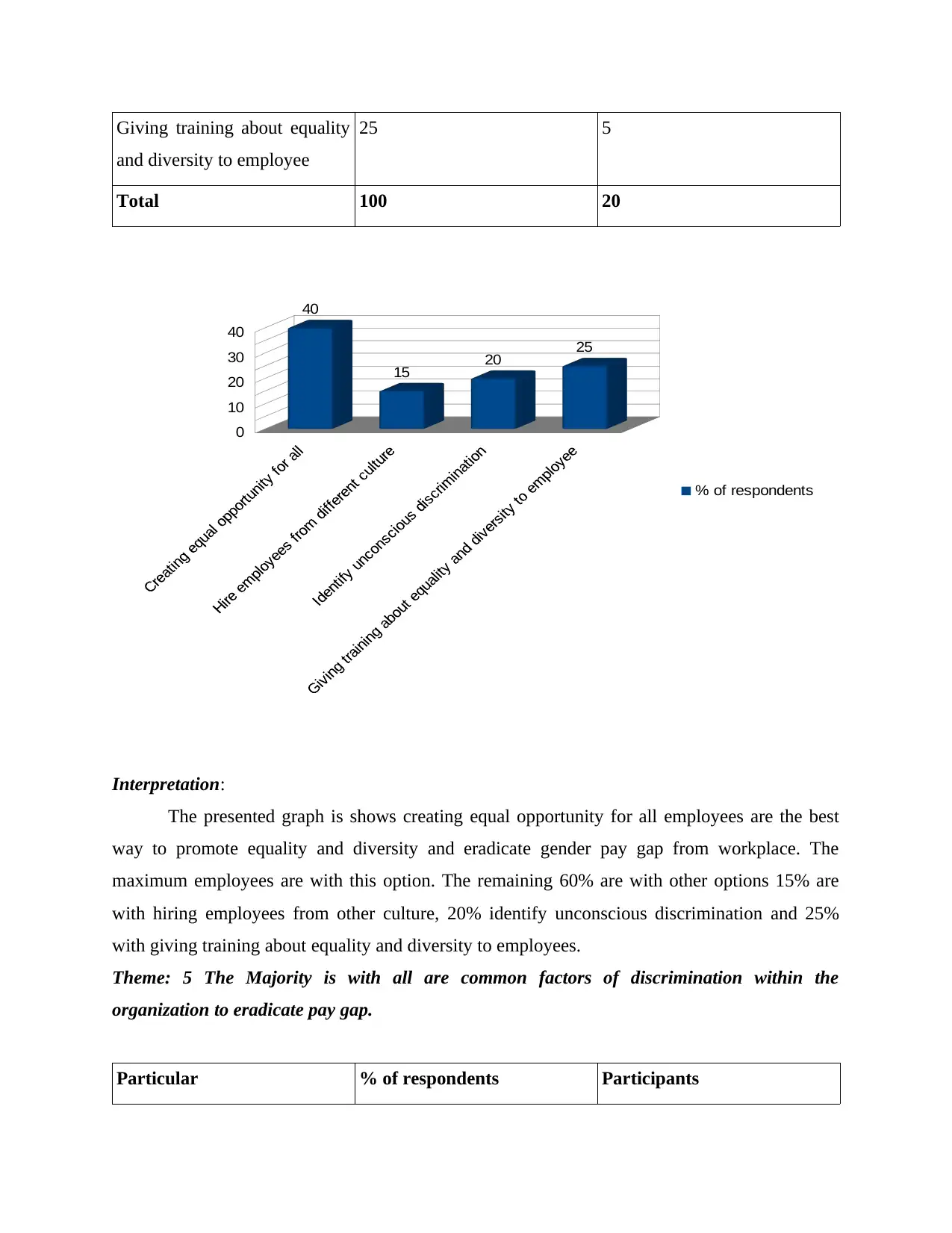
Giving training about equality
and diversity to employee
25 5
Total 100 20
Interpretation:
The presented graph is shows creating equal opportunity for all employees are the best
way to promote equality and diversity and eradicate gender pay gap from workplace. The
maximum employees are with this option. The remaining 60% are with other options 15% are
with hiring employees from other culture, 20% identify unconscious discrimination and 25%
with giving training about equality and diversity to employees.
Theme: 5 The Majority is with all are common factors of discrimination within the
organization to eradicate pay gap.
Particular % of respondents Participants
0
10
20
30
40
40
15 20 25
% of respondents
and diversity to employee
25 5
Total 100 20
Interpretation:
The presented graph is shows creating equal opportunity for all employees are the best
way to promote equality and diversity and eradicate gender pay gap from workplace. The
maximum employees are with this option. The remaining 60% are with other options 15% are
with hiring employees from other culture, 20% identify unconscious discrimination and 25%
with giving training about equality and diversity to employees.
Theme: 5 The Majority is with all are common factors of discrimination within the
organization to eradicate pay gap.
Particular % of respondents Participants
0
10
20
30
40
40
15 20 25
% of respondents
⊘ This is a preview!⊘
Do you want full access?
Subscribe today to unlock all pages.

Trusted by 1+ million students worldwide
1 out of 24
Related Documents
Your All-in-One AI-Powered Toolkit for Academic Success.
+13062052269
info@desklib.com
Available 24*7 on WhatsApp / Email
![[object Object]](/_next/static/media/star-bottom.7253800d.svg)
Unlock your academic potential
Copyright © 2020–2025 A2Z Services. All Rights Reserved. Developed and managed by ZUCOL.





